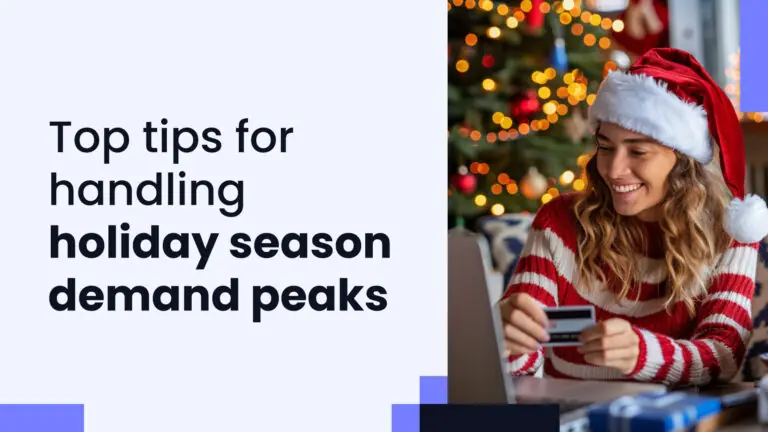There’s no escaping it – eCommerce sellers need to plan for seasonality. Consumers purchase more goods during the holidays and buying patterns differ based on the seasons and time of year. Are you ready to capitalize on temporary sales windows and take your seasonal offerings to the next level?
Fund your inventory with 8fig!
An understanding of how to capitalize on eCommerce seasonality is important for success in this dynamic industry. Fortunately, there are a number of strategies you can implement to make sure you maximize your sales in any season.
While fleeting growth periods pose unique challenges, the right preparation and execution can help you crush seasonal sales goals and yield lasting rewards.
Here are some proven tips to maximize success when selling seasonal products.
1. Start preparations early
Starting seasonal preparations well in advance is key to capitalizing on short sales periods. This should include everything from stocking up on inventory well in advance of the sales peaks to getting your marketing in order during the off seasons.
Pro tip
Start preparing for seasonal sales periods early to maximize sales. Stock up on inventory, prepare your marketing campaigns, and optimize your website and product listings.
Use accurate sales forecasting to figure out how much inventory you’ll need so you don’t run out of stock. Then, place your orders at least a few months before seasonal sales begin in order to ensure supply chain bottlenecks, disruptions, or delays don’t wreck your plans. It’s always wise to have a backup plan too, just in case your order gets held up.
Next, start optimizing product listings months before peak by incorporating seasonal keywords and highlighting competitive differentiators. Create optimized website content around seasonal topics to boost authority and rankings.
Set up and test marketing campaigns early to cement top organic positions before competition intensifies. You can also start building excitement with customers by starting your email campaigns early on. Sending out countdowns and teasers for holiday sales and specials is a great way to build momentum.
In addition, make sure you have the ability to handle increased traffic that comes with eCommerce seasonality. Test your website to check that it can handle the rush and put a customer support strategy in place. This will streamline your customer experience, boosting customer satisfaction and loyalty and leading to more sales.
We’ll ask a few quick questions to better understand your specific business needs. Then, we’ll build a funding plan tailored to your expenses.
Subscribe to the eCommerce newsletter for
top industry insights
Early preparation will pay off once your sales peak rolls around. You won’t have to worry about going out of stock and your customers will be ready and waiting to start making purchases.
Might also interest you:
2. Outrank competitors with targeted SEO
Potential buyers for your seasonal offerings often start their online searches during slower sales periods. Therefore, use this time strategically by outspending competitors early to gain better search visibility.
Dominating organic rankings before peak season hits translates into more visibility once seasonal shopping frenzies begin. You’ll already own that critical real estate, so you’ll be starting ahead of the competition.
Pro tip
Optimize your SEO strategy during the slow season. Dominating organic rankings before peak season translates into more visibility once seasonal shopping frenzies begin.
Here are some steps you can take to outrank competitors in search engine results:
- Research the keywords and content your target audience loves. Create SEO-optimized content that aligns closely with their searches and interests.
- Fine-tune your website’s technical structure to facilitate better crawling and indexing by search engines.
- Ensure your site architecture is easy for bots to navigate and comprehend.
- Address any server errors that could hinder listing pages from being indexed.
- Implement trusted SEO tools like SEMrush and Google Search Console to enhance visibility.
- Track keyword positions and SERP appearances monthly to gauge your SEO and content strategy progress.
3. Enhance product listings for maximum conversions
As peak season nears, shift your focus towards optimizing product listings and pages for higher conversions. Spruce up your descriptions with strategic keywords, incorporate compelling visuals, and refine your calls to action. This fine-tuning can significantly boost seasonal sales.
Here are some tips to help you improve your product listings ahead of seasonal sales:
- Create fresh, high-quality content to extend time on site and increase dwell time, which directly improves rank.
- Express the benefits – rather than just describing features, clearly articulating the benefits of your product can go a long way in convincing customers to click buy.
- Improve your photos – high quality product images are vital. Make sure your images clearly show the product from all angles. Include different variations and consider adding infographics to communicate key information.
- Ensure content originality – duplicate or repetitive content can negatively impact rankings.
- Optimize page load speeds through image compression, reduced server response times, and other tactics. Every second counts!
- Use descriptive header tags for better on-page SEO and readability.
- Research core and secondary keywords closely related to your seasonal offerings.
4. Streamline fulfillment and logistics with a 3PL
Leveraging third-party logistics (3PL) services is a game-changer for many sellers. By outsourcing inventory management and shipping to a 3PL provider, you ensure swift restocking to avoid damaging stockouts when seasonal demand spikes.
If you sell on Amazon, you can also utilize FBA, or Fulfillment by Amazon. This is a great way to take the pressure of fulfillment off of your shoulders so you can focus on other aspects of running your business. Plus, with FBA, you’ll be able to offer Prime shipping, a huge draw for potential customers.
Here are some of the key benefits of partnering with a 3PL:
- Avoid overspending on unused storage space by paying only for space used. 3PL pools storage needs across customers for maximum efficiency.
- Access advanced reporting and analytics for inventory insights, identifying operational improvement areas.
- Add value through expanded services like quality control checks, gift boxing, labeling, and last-mile delivery.
- Simplify supply chain orchestration. A 3PL seamlessly integrates various logistics partners like freight forwarders and carriers.
- Have a backup plan in place. 3PLs know the logistics business and are often able to quickly come up with alternative solutions should something go wrong in your supply chain.
With an adept 3PL as your inventory and shipping ally, you’re primed for seasonal selling success. Their expertise in swift restocking, analytics, and value-added services can help you deliver seamless customer experiences.
5. Offer special deals and time limited sales
Holiday offers and deals can help you rack up sales during peak selling season. Even if your product isn’t inherently seasonal, you can feature holiday colors and language in your advertising in order to draw more attention to your brand.
Pro tip
Get your customers excited for holiday sales and deals by sending out countdown emails and teasers. Play off of their FOMO (fear of missing out) and create a sense of urgency with limited time deals.
When it comes to marketing, playing off of customers’ FOMO, is a particularly effective strategy. Loss aversion describes a psychological principle where people feel a great deal of pain when they lose out on something. The fear of losing something can be a great motivator for potential customers.
In order to play off your customers’ fear of missing out, offer special, limited time deals for the holiday season. This adds a sense of urgency and increases the likelihood that consumers will make a purchase immediately. Another way to introduce FOMO is to advertise how many items are left. This encourages potential customers to buy your product fast, since they don’t want to miss out.
Free, fast shipping is another great way to get ahead when it comes to eCommerce seasonality. Many consumers are even willing to spend more money if shipping is free. Plus, high shipping costs are a top reason for cart abandonment. Consumers expect that shipping will be fast, too. Therefore, if you want to maximize sales, take a look at your shipping strategy.
Conclusion: Plan meticulously, execute relentlessly
Managing eCommerce seasonality and maximizing sales takes strategic foresight, optimization, and tenacity. But the effort pays off in the end.
By combining early preparation, SEO optimization, leveraging 3PL inventory and shipping, and fine-tuning listings, you can maximize success within compressed seasonal windows. Remember, consistent execution yields significant results – so make every moment count!
And if you need eCommerce funding to stock up on seasonal marketing or boost your marketing efforts, take a look at 8fig. We offer cash flow friendly, continuous, and equity-free funding to help online sellers reach their ultimate growth goals. Check out our seller stories to see how 8fig has helped real online sellers just like you.
Then, sign up for a Growth Plan of your own and win this holiday season.
Have article ideas, requests, or collaboration proposals? Reach out to us at editor@8fig.co – we’d love to hear from you.

![BFCM: The ultimate guide to eCommerce sales [2025]](https://www.8fig.co/wp-content/uploads/2023/09/cover-2-768x432.jpg.webp)
